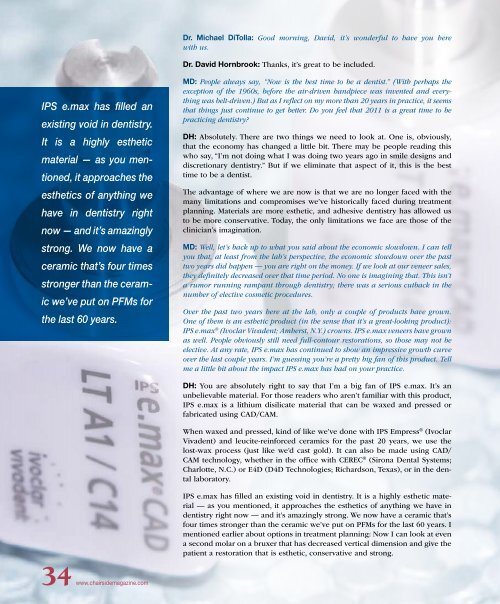Dr. Gordon Christensen The Dangers of - Glidewell Dental Labs
Dr. Gordon Christensen The Dangers of - Glidewell Dental Labs
Dr. Gordon Christensen The Dangers of - Glidewell Dental Labs
Create successful ePaper yourself
Turn your PDF publications into a flip-book with our unique Google optimized e-Paper software.
<strong>Dr</strong>. Michael DiTolla: Good morning, David, it’s wonderful to have you here<br />
with us.<br />
<strong>Dr</strong>. David Hornbrook: Thanks, it’s great to be included.<br />
IPS e.max has filled an<br />
existing void in dentistry.<br />
It is a highly esthetic<br />
material — as you mentioned,<br />
it approaches the<br />
esthetics <strong>of</strong> anything we<br />
have in dentistry right<br />
now — and it’s amazingly<br />
strong. We now have a<br />
ceramic that’s four times<br />
stronger than the ceramic<br />
we’ve put on PFMs for<br />
the last 60 years.<br />
MD: People always say, “Now is the best time to be a dentist.” (With perhaps the<br />
exception <strong>of</strong> the 1960s, before the air-driven handpiece was invented and everything<br />
was belt-driven.) But as I reflect on my more than 20 years in practice, it seems<br />
that things just continue to get better. Do you feel that 2011 is a great time to be<br />
practicing dentistry?<br />
DH: Absolutely. <strong>The</strong>re are two things we need to look at. One is, obviously,<br />
that the economy has changed a little bit. <strong>The</strong>re may be people reading this<br />
who say, “I’m not doing what I was doing two years ago in smile designs and<br />
discretionary dentistry.” But if we eliminate that aspect <strong>of</strong> it, this is the best<br />
time to be a dentist.<br />
<strong>The</strong> advantage <strong>of</strong> where we are now is that we are no longer faced with the<br />
many limitations and compromises we’ve historically faced during treatment<br />
planning. Materials are more esthetic, and adhesive dentistry has allowed us<br />
to be more conservative. Today, the only limitations we face are those <strong>of</strong> the<br />
clinician’s imagination.<br />
MD: Well, let’s back up to what you said about the economic slowdown. I can tell<br />
you that, at least from the lab’s perspective, the economic slowdown over the past<br />
two years did happen — you are right on the money. If we look at our veneer sales,<br />
they definitely decreased over that time period. No one is imagining that. This isn’t<br />
a rumor running rampant through dentistry; there was a serious cutback in the<br />
number <strong>of</strong> elective cosmetic procedures.<br />
Over the past two years here at the lab, only a couple <strong>of</strong> products have grown.<br />
One <strong>of</strong> them is an esthetic product (in the sense that it’s a great-looking product):<br />
IPS e.max ® (Ivoclar Vivadent; Amherst, N.Y.) crowns. IPS e.max veneers have grown<br />
as well. People obviously still need full-contour restorations, so those may not be<br />
elective. At any rate, IPS e.max has continued to show an impressive growth curve<br />
over the last couple years. I’m guessing you’re a pretty big fan <strong>of</strong> this product. Tell<br />
me a little bit about the impact IPS e.max has had on your practice.<br />
DH: You are absolutely right to say that I’m a big fan <strong>of</strong> IPS e.max. It’s an<br />
unbelievable material. For those readers who aren’t familiar with this product,<br />
IPS e.max is a lithium disilicate material that can be waxed and pressed or<br />
fabricated using CAD/CAM.<br />
When waxed and pressed, kind <strong>of</strong> like we’ve done with IPS Empress ® (Ivoclar<br />
Vivadent) and leucite-reinforced ceramics for the past 20 years, we use the<br />
lost-wax process (just like we’d cast gold). It can also be made using CAD/<br />
CAM technology, whether in the <strong>of</strong>fice with CEREC ® (Sirona <strong>Dental</strong> Systems;<br />
Charlotte, N.C.) or E4D (D4D Technologies; Richardson, Texas), or in the dental<br />
laboratory.<br />
IPS e.max has filled an existing void in dentistry. It is a highly esthetic material<br />
— as you mentioned, it approaches the esthetics <strong>of</strong> anything we have in<br />
dentistry right now — and it’s amazingly strong. We now have a ceramic that’s<br />
four times stronger than the ceramic we’ve put on PFMs for the last 60 years. I<br />
mentioned earlier about options in treatment planning: Now I can look at even<br />
a second molar on a bruxer that has decreased vertical dimension and give the<br />
patient a restoration that is esthetic, conservative and strong.<br />
34 www.chairsidemagazine.com
















